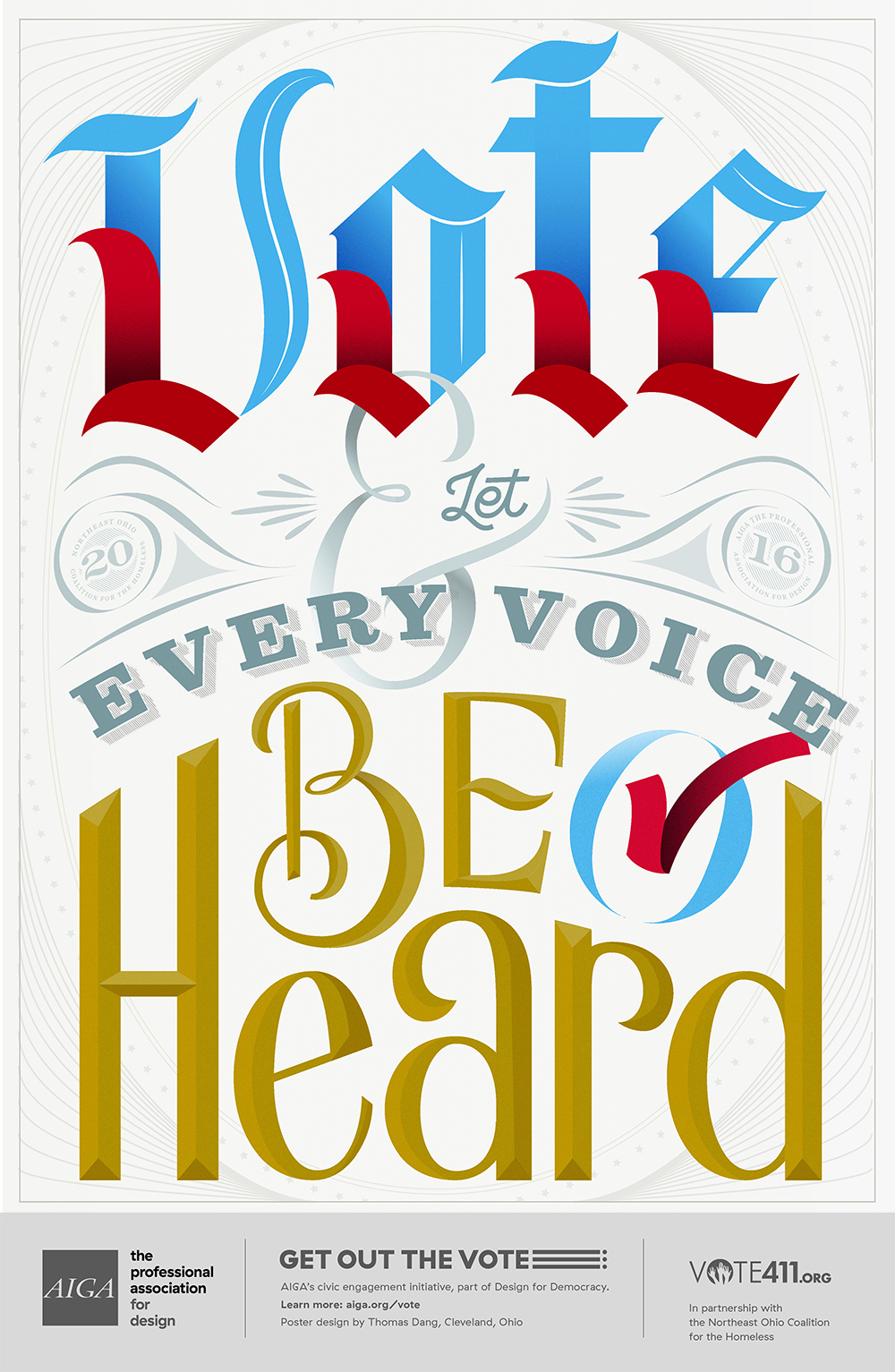Over the next few days we’ll be taking a closer look at the organizations and designers who participated in the Get Out the Vote: Design + Community Project with a series of Q&As. First, we’re highlighting the Northeast Ohio Coalition for the Homeless (NEOCH).
There is a large gap in voter turnout between those who have lived at their current address for less than a year and those who have lived at their current address for more than 5 years. This gap is mostly due to the fact that you must re-register to vote at your new address and identify and find transportation to your new polling location.
But what about the homeless? Without a permanent address, can they vote too? Absolutely yes. We asked NEOCH to participate in this project to help highlight the particular challenges of voting access for the homeless.

About NEOCH

The Northeast Ohio Coalition for the Homeless (NEOCH) is a non-profit coalition of service providers, housing activists, members, and homeless people. The reason that they are called a “coalition” is because they bring together diverse interests such as religious groups and homeless people along with social service providers under the common goal of finding solutions to homelessness. NEOCH activities, in partnership with homeless people, include the publication of a street newspaper, co-sponsorship of the Stand Down service fair, staffing for service and outreach collaborations, improving and expanding access to services, protecting the right to vote by homeless people, publication of a one page guide to all the services in Cleveland, and construction of a host of educational and advocacy activities.
For the Q&A with NEOCH we spoke to executive director, Brian Davis.
Q: What messages around voting do you want to convey to the audiences that you reach?
A: You don’t need a home to vote.
Q: In what ways do you think design will be able to help you speak to your audience?
A: We hope to use the poster as a symbol for homeless people voting in Cleveland. We want to have it displayed at the shelters and service locations to show how important voting is in the community. We want it to be so visible that it will remind homeless people that they need to participate and they need to vote.
Q: What made you want to participate in this project?
A: Voting is at the core of our organization’s mission. We have to have our population vote or we will fail in our advocacy/public policy work. We need to be able to sit across the table from politicians to say that homeless people do vote so you need to pay attention to our issues. Anything we can do to combine art and artists to improve our advocacy we are interested in doing. We believe that advertising, art and creative ways to get across your message can move our advocacy forward. Voting is a chore that we all need to do, and sometimes you need a little sugar to help those pills go down.
About Designer Thomas Dang

Thomas Dang is a Designer, Photographer and First Degree Black Belt from Cleveland Ohio. Graduating from Cleveland State University with a degree in Design and Psychology he is very intrigued by consumer behavior, and how imagery affects said behavior. Oh, and he’s a rapper. Sort of…
Q: Did you walk in to your first meeting with NEOCH with any pre-existing notions or ideas of how you might be able to reach their audience?
A: I had a general idea. I know certain language and imagery doesn’t resonate with the urban poor/underclass. I also wanted to avoid coming across as patronizing or condescending. Coming from the same background as the target audience I’ve seen lots of messaging in PSA materials that really talk down to the audience. I also wanted to avoid being to upbeat.
Q: How did you interpret the message of NEOCH in one cohesive design/message?
A: I don’t think I did. Part of NEOCH’s goals is to challenge laws that make it harder for the homeless to vote. I think the very idea that these laws were put into place may make a marginalized person think “what’s the point, they’ll just figure out another way to discount my vote.” Instead I tried to focus on the actionable part of the initiative and speak to the equalizing impact that voting can have.
Q: In what ways do you hope your designs might impact the organization’s audience?
A: I really believe in planting seeds of ideas in people, like inception but in real life. The key message I was really trying to communicate was regardless of your social status your thought and opinions have value. I think when people get down on their luck they start to doubt their self worth. Not only that, but people become so disenchanted with the existing social system, that they feel as if they should continue living under the foot of society because things will never change. I think these are both great injustices to the human spirit. The poster is so ephemeral that it’s almost insignificant, but perhaps it can be like a grain of sand in an oyster, something to agitate them inside and it just continues growing over time.
Q: Did you resonate with the organization in any way or have any close connection that made you excited to work with NEOCH in particular?
A: I really wouldn’t describe the feeling as excitement; I chose to work with NEOCH out of a sense of duty to do something for the community I represent. I grew up very poor, being evicted from almost every house I lived in as a child, with my family and many childhood friends constantly treading the line between struggling and being completely destitute. Within the past three months several people very close to me have been on the brink of homelessness, and a relative committed suicide due to depression onset by financial hardships. The issue of being impoverished and marginalized is very real to me, so I felt that I would not only bring an extra level of insight but I would have an opportunity to create a message with undertones of hope and empowerment.
I also seek out these kinds of experiences to help keep things in perspective. What designer doesn’t want more creative freedom, and at times I find myself griping about certain aspects of doing client work (i.e. mounting boards). But the fact of the matter is that I have a pretty stable career in a solidly middleclass field. Opportunities like these allow me to reflect on things and, really appreciate those who have seen potential in me and helped me in my journey.
Thank you to NEOCH and Thomas for participating in this project! There is still more behind the scenes video footage, interviews, and photos to come with NEOCH and Thomas so keep your eye on the AIGA Cleveland blog and social media.
Sponsors


Special Thanks to
NEOCH, The League of Women Voters, OCA, Thomas Dang, Nolan Beck, & Aly Dodds